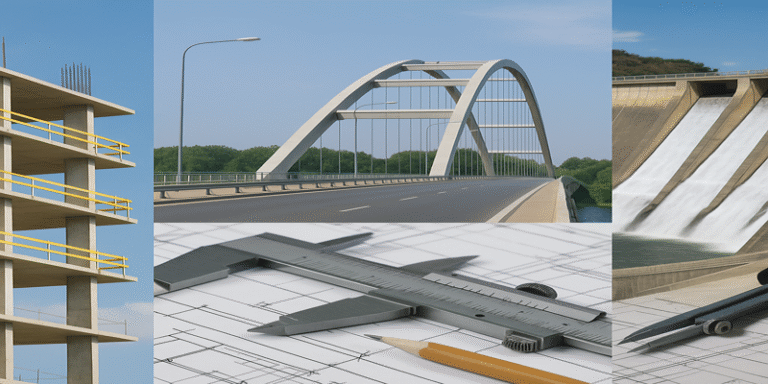At the heart of statics lies the concept of equilibrium, which occurs when all the forces and moments (torques) acting on a body are perfectly balanced. A system in equilibrium has no net force and no net moment acting on it, meaning it will remain stationary. The two main conditions for static equilibrium are:
- ΣF = 0: The vector sum of all forces acting on the body is zero.
- ΣM = 0: The sum of all moments about any point is zero.
These simple-looking equations form the basis for analysing everything from truss structures to retaining walls, enabling engineers to calculate whether a given configuration of materials will stand firm under applied loads (Beer et al., 2015).
1.0 Application of Statics in Civil Engineering
Statics is perhaps most famously associated with civil engineering, where it is crucial to ensure that buildings, bridges, and other infrastructure can resist the loads placed on them.
1.1 Bridges
For instance, in designing a suspension bridge, engineers must account for dead loads (the weight of the structure itself), live loads (vehicles, pedestrians), wind loads, and seismic forces. Using static analysis, they determine how forces are distributed across cables, towers, and deck sections (Chen & Duan, 2014).
1.2 Buildings
In building design, especially for high-rise structures, static principles are applied to assess how columns, beams, and foundations carry and transmit loads. Architects and engineers rely on load path analysis—a concept derived from statics—to determine how weight is safely transferred to the ground (McCormac & Nelson, 2016).
1.3 Dams and Retaining Walls
For dams and retaining walls, static equilibrium helps analyse hydrostatic pressure and earth pressure. These calculations ensure that such structures won’t topple or slide under pressure from water or soil (Das & Sivakugan, 2018).
2.0 Application of Statics in Mechanical and Aerospace Engineering
Statics also plays a foundational role in mechanical engineering, where it is used to design machines, tools, and support systems.
In mechanical systems, understanding how components like shafts, beams, and joints react to forces ensures safety and functionality. For example, when designing a robotic arm, engineers use statics to determine how much torque each joint must resist when the arm holds an object at a certain angle (Hibbeler, 2017).
In aerospace engineering, although dynamics often takes the spotlight, statics is essential in the design of aircraft wings and fuselage supports. These parts must withstand significant forces without any movement during takeoff, flight, or landing.
3.0 Application of Statics in Structural Engineering and Architecture
In structural engineering, statics informs decisions on load-bearing elements, materials, and geometries.
Structural designers use static analysis to:
- Select proper cross-sectional areas for beams.
- Calculate support reactions for overhangs.
- Design trusses and arches that redistribute loads efficiently.
Architects also apply these principles, ensuring their aesthetic visions are structurally viable. As Salvadori and Levy (2002) explain, “form must follow function,” but function must first follow static stability.
4.0 Real-World Failures: When Statics is Ignored
Statics not only supports innovation but also serves as a warning system. Some of the most infamous engineering failures are attributable to errors in static analysis.
- The Tacoma Narrows Bridge (1940), although mainly a failure in dynamic analysis, revealed a fundamental misunderstanding of how aerodynamic forces interact with static load distributions.
- The Hyatt Regency walkway collapse (1981) in Kansas City resulted from a miscalculation in load distribution, a core static principle (Moncarz & Taylor, 2000).
These tragedies underscore that ignoring static equilibrium can result in catastrophic consequences.
5.0 Modern Tools for Static Analysis
Today, engineers no longer rely solely on hand calculations. Finite Element Analysis (FEA) has revolutionised static analysis by allowing the evaluation of large, complex structures with thousands of interconnected parts.
Software tools like ANSYS, SolidWorks, and Autodesk Robot simulate how static forces behave in virtual models. These tools apply Newtonian mechanics in discrete intervals to visualise stress distribution, deformation, and potential failure zones (Cook et al., 2002).
6.0 Education and Learning in Statics
Statics is typically one of the first technical courses that engineering students encounter. It forms the basis for understanding more advanced topics like structural mechanics, materials science, and fluid dynamics.
Interactive simulations, 3D models, and physical experiments are now used in engineering education to help students grasp the visual and mathematical nature of static equilibrium (Impelluso, 2009).
7.0 Challenges and Future Directions
While statics itself is a mature field, its integration with other technologies—such as artificial intelligence, machine learning, and building information modelling (BIM)—is opening new frontiers. For instance, AI-driven design platforms can automatically run static analyses to optimise structures in real time (Zhao et al., 2020).
Moreover, the rise of sustainable engineering demands that structures not only be stable but also resource-efficient. Statics now works in tandem with green engineering to create designs that are both strong and environmentally responsible.
8.0 The Invisible Backbone of Stability
Statics may not boast the glamour of rocket launches or the excitement of moving parts, but it remains the silent backbone of our engineered world. Every building that stands tall, every bridge that spans a river, and every dam that holds back water exists because of the meticulous application of static equilibrium principles.
Whether through classical equations or digital simulation, the art and science of keeping things still is what allows everything else to move forward.
References
Beer, F. P., Johnston, E. R., Mazurek, D. F., & Eisenberg, E. R. (2015). Vector Mechanics for Engineers: Statics (11th ed.). McGraw-Hill Education.
Chen, W.F., & Duan, L. (2014). Bridge Engineering Handbook: Fundamentals (2nd ed.). CRC Press.
Cook, R. D., Malkus, D. S., Plesha, M. E., & Witt, R. J. (2002). Concepts and Applications of Finite Element Analysis (4th ed.). Wiley.
Das, B.M., & Sivakugan, N. (2018). Principles of Foundation Engineering (9th ed.). Cengage Learning.
Hibbeler, R. C. (2017). Engineering Mechanics: Statics (14th ed.). Pearson.
Impelluso, T. J. (2009). Assessment of student learning using interactive 3D statics problems. International Journal of Engineering Education, 25(2), 249–258.
McCormac, J. C., & Nelson, J. K. (2016). Structural Steel Design (6th ed.). Pearson.
Moncarz, P. D., & Taylor, R. K. (2000). Hyatt Regency Walkway Collapse. Journal of Performance of Constructed Facilities, 14(4), 162–166.
Salvadori, M., & Levy, M. (2002). Why Buildings Stand Up: The Strength of Architecture. Norton.
Zhao, D., McCoy, A. P., Bulbul, T., & Haines, R. (2020). AI-enhanced BIM and structural analysis integration. Automation in Construction, 116, 103214.









